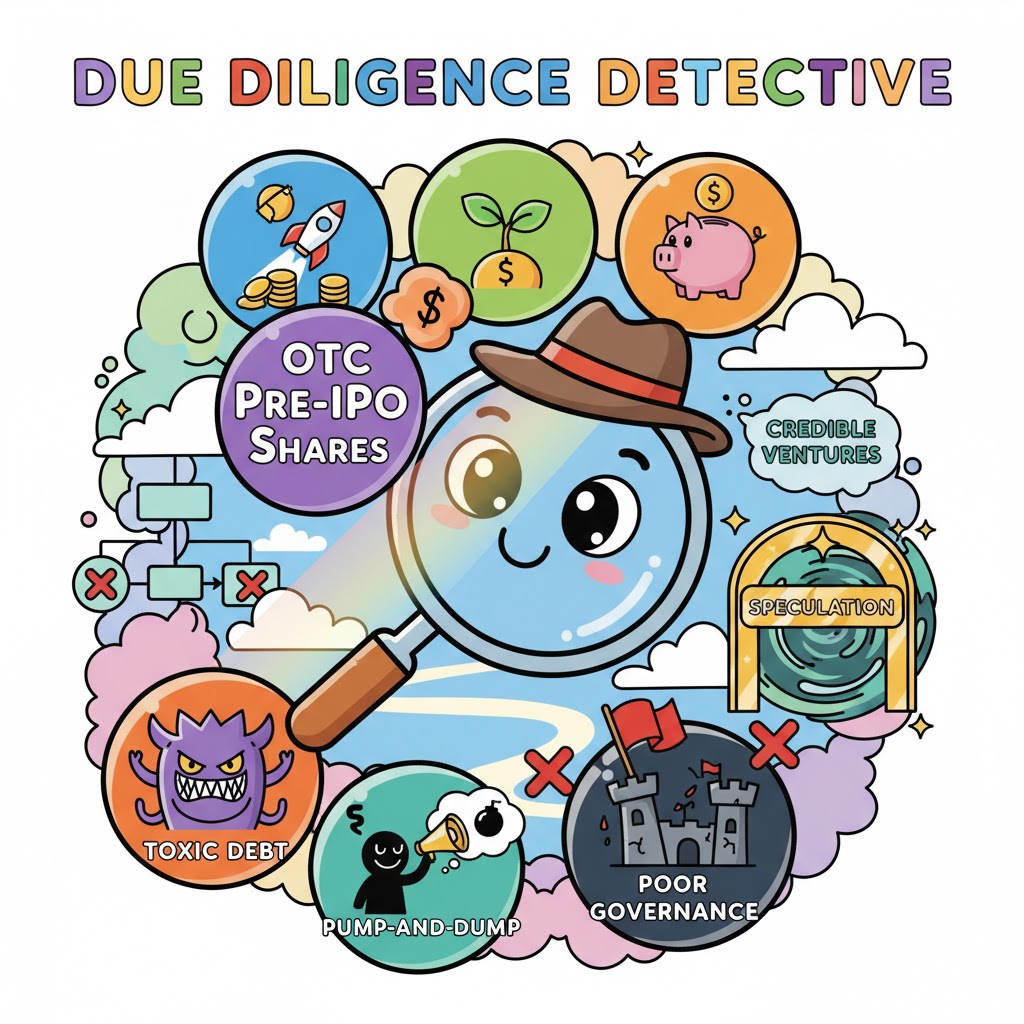High Risk or Hidden Opportunity? Due Diligence When Investing in OTC IPOs and Pre-IPO Shares
Posted onThe allure of early-stage investing — buying before a company uplists or achieves exchange-level recognition — has long attracted investors to the OTC Markets. Some investors see these opportunities as hidden gems poised to graduate to the Nasdaq or NYSE. Others, however, have learned the hard way that many OTC “pre-IPO” shares are high-risk, thinly traded, and sometimes manipulated.
While the OTC ecosystem includes legitimate emerging issuers, it also houses development-stage companies, shells, and promotional ventures that lack operational depth. The key to navigating this terrain is due diligence — understanding the company’s regulatory status, disclosure practices, capitalization, and governance before investing.
This article explains how informed investors, advisors, and family offices can distinguish credible OTC opportunities from high-risk speculation, drawing on Hamilton & Associates’ experience in representing issuers and investors across all OTC tiers.
The Rise of OTC IPOs and Pre-IPO Investments
The term “OTC IPO” generally refers to a company’s first quotation on the OTCQB, OTCQX, or OTCID markets following qualification under SEC Rule 15c2-11. Unlike traditional exchange IPOs, which involve underwriters and formal prospectuses, OTC offerings often rely on direct placements or Reg D/Reg A+ exemptions.
Common pathways include:
- Regulation A+ offerings, allowing smaller companies to raise up to $75 million with lighter reporting;
- Private placements under Regulation D, followed by public quotation under Rule 15c2-11; and
- Reverse mergers, in which private operating companies merge with existing public shells.
Each of these structures can create legitimate investment opportunities — or, if poorly structured, expose investors to extreme dilution and limited liquidity.
Understanding the Regulatory Framework
A. Rule 15c2-11 and Broker-Dealer Due Diligence
Before any security can be quoted on the OTC Markets, a market maker must file a Form 211 under Rule 15c2-11 with FINRA. The broker-dealer must review the issuer’s financial statements, management background, and corporate disclosures to ensure accuracy and completeness.
This process is intended to filter out companies lacking verifiable public information. If an issuer does not meet these standards, its securities cannot be publicly quoted — one of the major reforms from the SEC’s 2021 modernization of Rule 15c2-11.
B. The Role of OTC Markets Group
OTC Markets Group now designates issuers under OTCQX, OTCQB, or OTCID, signaling to investors the level of disclosure and compliance. A company trading on OTCQX or OTCQB that is current in its SEC reporting is generally a safer environment for investors than an OTCID issuer with limited information.
Financial and Legal Red Flags
Investors should approach any OTC IPO or pre-IPO share purchase with heightened skepticism if they identify:
- Unaudited financials or non-PCAOB audit firms;
- Convertible debt with variable conversion rates (“toxic debt”);
- Promotional campaigns preceding quotation;
- Frequent management or auditor changes;
- No independent directors or audit committee;
- Unusually high insider ownership with limited float.
Such red flags often precede SEC trading suspensions, delistings, or enforcement actions.
Disclosure and Transparency Review
A disciplined investor should always begin with disclosure. On the OTC Markets website, review the issuer’s profile:
- Financial reporting frequency (quarterly and annual);
- Attorney letter with respect to current information;
- Share structure updates (authorized, issued, and outstanding shares);
- Corporate actions filed with FINRA; and
- Presence of a Caveat Emptor warning or risk flag.
If the company is an SEC registrant, cross-check filings on EDGAR. Missing or amended reports, restatements, or auditor resignations are material warning signs.
Issuers that fail to file Form 8-Ks following major events — such as control changes, financings, or management turnover — may already be under regulatory scrutiny.
Capital Structure and Dilution Analysis
The single greatest risk to OTC investors is dilution. Many small issuers finance operations through convertible notes or preferred shares that convert into common stock at deep discounts. These structures can cause exponential share issuance, collapsing stock prices and eroding investor value.
Key metrics to examine:
- Authorized shares vs. outstanding shares — excessive authorized shares suggest future dilution;
- Recent amendments to increase share authorization or reverse split the stock;
- Note conversion terms — particularly floating conversion prices tied to market discounts;
- Disclosure of related-party debt or insider financing.
Promotional Activity and Manipulation Risks
Investors should evaluate whether an OTC issuer’s stock performance coincides with aggressive public relations, paid research, or social-media hype.
The SEC, FINRA, and OTC Markets actively monitor for patterns consistent with “pump-and-dump” manipulation. OTC Markets’ Promotion Flag and Caveat Emptor symbols alert investors when promotional activity is suspected.
Red flags include:
- Press releases with exaggerated claims;
- Paid “analyst” or newsletter coverage without disclosure;
- Sudden volume spikes following promotional emails or social-media posts.
In 2024, the SEC suspended trading in more than 40 microcap issuers for misleading promotion campaigns. Investors should always verify the source of information and seek company confirmation through official filings.
Corporate Governance and Legal Oversight
Sound governance separates credible issuers from speculative ventures. Look for:
- Independent directors with verifiable professional backgrounds;
- Established audit and compensation committees;
- Adoption of a corporate code of ethics;
- Independent transfer agent participation; and
- Disclosure of beneficial ownership under Regulation S-K Item 403.
Companies that lack these structures often rely on insiders or promoters with undisclosed control, raising serious investor-protection concerns.
Issuers on the OTCQX and OTCQB tiers must certify annually that they meet minimum governance requirements — a strong sign of internal accountability.
Legal and Compliance Verification
Investors should verify whether an issuer:
- Has engaged qualified securities counsel experienced in OTC reporting;
- Retains a PCAOB-registered auditor; and
- Uses a recognized transfer agent listed with FINRA.
At Hamilton & Associates Law Group, we often perform independent compliance audits for clients evaluating OTC investments, reviewing legal opinions, 15c2-11 filings, and FINRA responses for irregularities.
Evaluating Pre-IPO and Pre-Uplist Opportunities
Investing before an uplisting can be lucrative — but only when the company has a realistic path to exchange eligibility. Confirm:
- The issuer’s target exchange (Nasdaq Capital Market or NYSE American);
- Financial benchmarks relative to listing standards;
- Corporate governance reforms underway; and
- Filing of preliminary applications or correspondence with exchange staff.
Legitimate uplisting candidates often disclose these developments in Form 8-Ks or press releases detailing corporate milestones.
Beware of issuers that reference “plans to uplist” without specific actions, filings, or advisor engagement — vague claims are a hallmark of speculative promotion.
The Role of Counsel and Advisors
Engaging knowledgeable securities counsel before investing can prevent significant losses. Experienced attorneys can:
- Review offering documents and subscription agreements;
- Verify exemptions claimed under Regulation D, A+, or S;
- Analyze dilution risk and capitalization tables; and
- Identify potential undisclosed control persons or past disciplinary actions.
Firms familiar with SEC, FINRA, and OTC Markets oversight — such as Hamilton & Associates — can interpret subtle disclosure signals that indicate compliance quality.
Practical Investor Checklist
Before investing in any OTC IPO or pre-IPO company, confirm:
- Current disclosure status on OTC Markets or EDGAR;
- PCAOB-audited financial statements;
- Absence of Caveat Emptor or Promotion flags;
- Independent directors and audit committee;
- No outstanding toxic convertible debt;
- Transparent share structure;
- Verified transfer agent and auditor information;
- Clean record of SEC and FINRA filings.
A free investor resource: OTC Due Diligence Checklist
Conclusion
Investing in OTC IPOs and pre-IPO shares can provide early access to growth companies that may eventually uplist to the Nasdaq or NYSE. Yet these opportunities require discipline, skepticism, and professional guidance.
Legitimate OTC issuers can provide strong returns for investors who conduct proper diligence. Conversely, failing to evaluate disclosure quality, capitalization, and promotional activity can lead to losses long before the company reaches an exchange.
At Hamilton & Associates Law Group, we help investors and issuers navigate the evolving OTC landscape — ensuring that compliance, transparency, and investor protection remain at the center of every transaction.
To speak with a Securities Attorney, please contact Brenda Hamilton at 200 E Palmetto Rd, Suite 103, Boca Raton, Florida, (561) 416-8956, or by email at [email protected].
Hamilton & Associates | Securities Attorneys
Brenda Hamilton, Securities Attorney
200 E Palmetto Rd, Suite 103
Boca Raton, Florida 33432
Telephone: (561) 416-8956
Facsimile: (561) 416-2855
www.SecuritiesLawyer101.com







